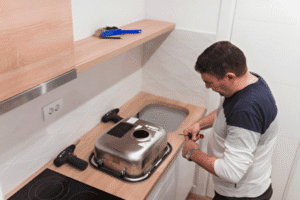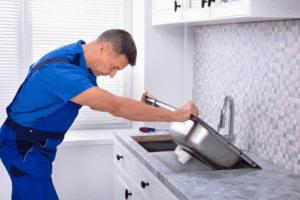Are you tired of your outdated kitchen sink? A new kitchen sink installation can completely transform the look and functionality of your space. Whether you’re renovating your kitchen or simply replacing an old, worn-out sink, a proper installation ensures both aesthetic appeal and lasting performance. At JLM Handyman Services, we make kitchen sink installation easy, hassle-free, and affordable. Let us guide you through the process and provide expert service that guarantees your kitchen sink works flawlessly for years to come.

A well-installed kitchen sink is more than just a functional feature—it’s the heart of your kitchen. Whether you’re washing dishes, preparing meals, or cleaning up, a sink that’s installed properly ensures smooth daily tasks and long-lasting performance.
Kitchen sink installation impacts not only how efficiently your kitchen operates but also its overall aesthetic. A quality installation helps prevent leaks, saves water, and enhances the overall look of your kitchen, making it a crucial upgrade.
Before you begin the installation process, selecting the right sink is crucial. There are several types of kitchen sinks available, each with its own benefits. The most common options include:
Take your time to choose a sink that matches your kitchen’s style and meets your needs. Don’t forget to consider the material, size, and configuration of the sink, as well as the compatibility with your existing plumbing.
Having the right tools and materials on hand will make your kitchen sink installation process much easier. Here is a list of essential items you’ll need:
Ensure that you have all the necessary items before you start the project. This will prevent unnecessary delays and complications during the installation process.

Before starting your kitchen sink installation, it’s crucial to prepare the area properly. First, turn off the water supply to avoid any leaks. Remove the old sink if needed, and clean the countertop space.
Measure the area to ensure your new sink fits perfectly. Clearing the surrounding space also makes it easier to work and helps prevent any mess. Taking these steps ensures a smooth, efficient installation, making the process hassle-free and successful.
Installing the faucet and drain assembly is a crucial step in the kitchen sink installation process. Proper installation ensures a leak-free setup and smooth water flow. Follow the manufacturer’s instructions for each component to avoid potential issues down the line. Let’s dive into how to do it step by step.
The next step in kitchen sink installation is mounting the sink in place. If you are installing a top-mount sink, place the sink into the countertop cut-out, ensuring that it fits securely. For undermount sinks, you’ll need to attach the sink to the underside of the countertop with specialized mounting clips and adhesive.
Be sure to follow the manufacturer’s guidelines to guarantee a secure fit. During this stage, you’ll want to apply silicone caulk around the edges of the sink to create a watertight seal. This helps prevent any leaks around the sink’s perimeter.
Once your kitchen sink is in place, it’s time to connect the plumbing. This step ensures that water flows smoothly to and from your sink, making it fully functional. Proper installation and secure connections are essential to avoid leaks and water damage. Here’s how to connect your plumbing:
Once your kitchen sink is in place, the next crucial step is sealing and securing it properly. A secure sink ensures no leaks and a long-lasting installation. Apply a bead of silicone caulk around the edges to create a tight seal between the sink and countertop, preventing water damage.
Tighten any mounting hardware to ensure stability. By taking these extra steps, you’re ensuring your kitchen sink installation is both secure and leak-free for years of dependable use.

While installing a kitchen sink might seem like a simple DIY task, it requires precision and expertise to get it right. From ensuring proper plumbing connections to preventing leaks, professionals bring the knowledge and tools necessary for a smooth, trouble-free kitchen sink installation that lasts.
Whether you’re upgrading your kitchen or replacing an old sink, JLM Handyman Services is here to help with professional kitchen sink installation. We offer reliable, efficient, and affordable services to meet your needs.

Call us today at 443-362-1179 or book an appointment online at JLM Handyman Services. Let us help you create the kitchen of your dreams with a perfectly installed sink!
✅ When selecting a kitchen sink, consider factors like material, size, style, and configuration. Popular options include top-mount, undermount, and farmhouse sinks. Make sure your choice complements your kitchen design and fits the countertop space, and don’t forget to check compatibility with your plumbing.
✅ While it’s possible to install a kitchen sink yourself, it requires plumbing knowledge and the right tools. Mistakes can lead to leaks or water damage. Hiring a professional ensures a secure, leak-free installation and saves you time and hassle.
✅ The installation time varies depending on the type of sink and the complexity of the plumbing. On average, a professional can complete the installation in 2-4 hours. For more intricate installations, such as undermount sinks, it may take a bit longer.
✅ You’ll need basic tools like an adjustable wrench, pipe wrench, plumber’s tape, silicone caulk, and a pipe cutter. It’s essential to have all tools ready to ensure a smooth and efficient installation process.
✅ Sealing the sink with silicone caulk is crucial to prevent water from seeping under the sink, which can cause damage to the countertop and cabinets. A proper seal also keeps your kitchen clean, dry, and free from potential leaks over time.